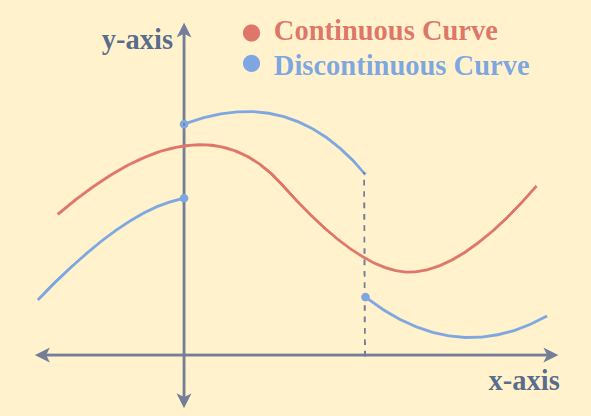Real Life Applications of Continuity
Last Updated :
04 Apr, 2024
Continuity is one of the basic properties of functions that help us to predict the flow of functions without abrupt changes. In mathematics, a function is said to be continuous in a given interval if there is no break in the graph of the function in the entire interval range.
In this article, we take a look at continuity in real-life situations and its correct use in difficult situations.
What is Continuity?
A function “f” is said to be continuous in a closed interval [a, b] if
- f is continuous in (a, b)
- limx→a+ f(x) = f(a)
- limx→b- f(x) = f(b)
Assume, “f” is a real function on a subset of real numbers and “c” is a point in the domain of f. Then f is continuous at c if,
limx→c f(x) = f(c)

Applications of Continuity
Continuity (or concept of continuous function) is used in optimization problems for finding maximum and minimum values of the function to experience a smooth change of state. Signal processing has a wide variety of applications which require continuous functions such as analysing and manipulating signals in audio processing and image processing.
Now let’s lear about various real-life applications of continuity.
Real Life Applications on Continuity
Various application of concept of continuity in real life are added below:
Engineering and Design
Continuity is very important in engineering and designing as it guarantees the proper functioning and stability of the system as a whole. Engineers employ a variety of functional forms for modeling of real-world manifestations, such as fluid dynamics, structural approaches and electrical schemes.
Example: Continuity is one of the principles used by civil engineers to develop bridges and buildings that can tolerate different kinds of forces and climatic conditions.
Economics and Finance
Concept of continuity in economics and finance is important in modeling economic cycle and markets analysis. Economists represent supply and demand curves, production functions, and utility functions respectively as continuous functions. Using continuity analysis, economists can analyze economic systems stability, tendency of trends in the market, and develop some solutions and policy decisions.
Example: Financial analysis discipline incorporates continuity principles to forecast perception of the financial markets and determine risk in investment portfolios.
Physics and Natural Sciences
Continuity is one of the concepts in physics and natural sciences to describe the way to some systems to behave and some phenomena to occur. Physicists often use continuous functions to describe motion, waves as well as quantum processes such as the electron spin. Continuity analysis works wonders when it comes to experiment predictions as well as gives rise to formulation of laws that govern nature, and helps in development of new technologies.
Example: Astronomers apply continuity principles to simulate the orbits of celestial bodies and forecast astrological factors such as eclipses and planet transits.
Computer Science and Information Technology
Continuity concepts play an important role in computer science and information technology by providing for algorithm design, data analysis, and application system development. Computer scientists uses mathematical functions to describe computational process, data structures and algorithms through Continuity. Continuous analysis of programs allows programmers to optimize their execution, increase scalability and ensure reliability of the system.
Example: Machine learning engineers will apply the continuity principles, so as to train the neural networks and model the data patterns and predictive analytics, with the understanding of the activation functions and loss functions continuity, engineers can fine-tune the models to be more accurate and precise in the machine learning tasks.
Environmental Science and Climate Modeling
Continuity is crucial in environmental science and climate modeling as it is essential to record Earth’s atmosphere, oceans, and ecosystems. Environmental scientists often resort to continuous functions to simulate weather, climate change and eco-dynamics tendencies. Continuity analysis aims at revealing interconnectedness of environmental processes and determining what human impacts can be on planet.
Example: Using the continuity principles, the climate scientists base their mathematical models of the Earth’s climate system and the simulation of future climate scenarios.
Medical Imaging and Signal Processing
Continuity principles are a key part of Medical Imaging and signal processing because it helps in processing biomedical signals and obtaining images from the scans. In medical research, continuous functions are used to get representations of physiological processes, for example, brain activity, heart rate, and blood flow.
Example: Continuity principles are utilized in magnetic resonance imaging (MRI) to make high-resolution images with a quality that shows the internal organs and tissues in detail.
Robotics and Automation
Continuity concepts have a significant impact on robotics and automation because they are used to plan, trajectories, and control systems, as well as instrumenting robots movements. Robotic engineers uses continuous functions to develop trajectory generation, force feedback and motion detectable robot arms. It also contributes in various tasks in industrial automobiles and vehicles.
Example: Within robotic manufacturing, continuity concept is utilized to prepare robotic arms for precise motion control and the path planning.
Related Articles
FAQs on Continuity
What are the applications of limit and continuity?
Concept of continuity is important in many fields, such as physics, economics, and engineering, and are used to model and optimize various situations.
Why is continuity important in real-life applications?
Continuity is important in real-life use cases because it allows to model and predict behavior of complex systems, solve dilemmas and provide practical solutions across many fields of practice such as engineering, economics, and environmental science.
What are the real applications of limits?
Limits have various applications in real life scenerious, i.e. they helps to measure the strength of the magnetic field, electric field, etc.
Share your thoughts in the comments
Please Login to comment...